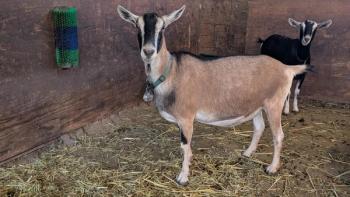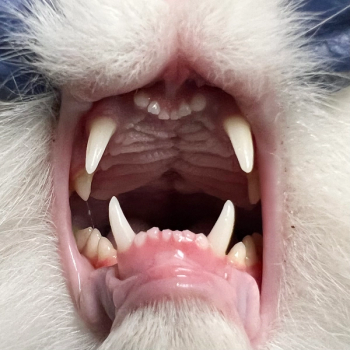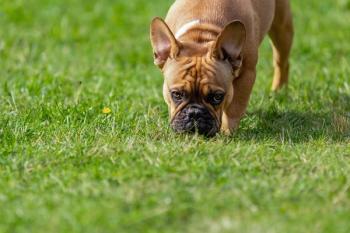
Surgery of the stomach (Proceedings)
Normal Anatomy: The stomach is divided into the cardia, fundus, body, and pyloric antrum and the esophagus enters the stomach through the cardiac ostium.
Normal Anatomy: The stomach is divided into the cardia, fundus, body, and pyloric antrum and the esophagus enters the stomach through the cardiac ostium. The pyloric antrum normally resides on the right side of the animal.
Anatomy
The gastric and gastroepiploic arteries supply the stomach and are branches of the celiac artery. The gastric artery supplies the less curvature of the stomach and the gastroepiploic artery supplies the greater curvature of the stomach. The short gastric arteries arise from the splenic artery and also contribute to the blood supply of the greater curvature. The portion of the lesser omentum that passes from the stomach to the liver is known as the hepatogastric ligament.
Gastrotomy:
Indications: Foreign body removal, gastric biopsy and gastric exploration.
Arteries
Approach: Cranial ventral midline celiotomy.
Procedure: Following entrance into the abdomen Balfour retractors and used to retract the abdominal wall and provide exposure to the stomach and the rest of the gastrointestinal tract. To decrease contamination the stomach should be isolated from the remaining abdominal contents with moistened laparotomy sponges. Stay sutures (3-0 Nylon or Polypropylene) should be placed to help manipulate the stomach and decrease the chances of contamination. Make a gastric incision on the ventral surface of the stomach in an area that appears hypovascular between the greater and lesser curvature. Make sure that your intitial incision is not near the pylorus so that wound closure does not cause an outflow obstruction. Next, make a stab incision into the lumen of the stomach with a No. 11 scalple blade. You will notice that it is difficult to make the initial stab incision due to the strength of the submucosa. Extend the incision with Metzenbaum scissors. Stomach contents should be suctioned to remove stomach contents and decrease the chances of spillage. Explore the stomach to find foreign bodies. Make sure that your gastrotomy is large enough to easily remove the foreign body. If it is to small you will unnecessarily traumatize the stomach.
Closure: Close the stomach with 2-0 or 3-0 absorbable suture material (PDS or Maxon) in a two layer continuous inverting suture pattern. Include the serosa, muscularis, and submucosa in the first layer, using a Cushing or Lembert pattern. Follow it with a Cushing or Lembert pattern that incorporates the serosal and muscularis layers. Substitute sterile instruments and gloves for ones contaminated by gastric contents, before closing the abdominal wall. Check the entire intestinal tract for additional material that could cause an intestinal obstruction.
Gastrotomy incision
Complications:
Postoperative complications are rare. Vomiting is to be expected in the postoperative period for up to 24 hours. Dehiscence is uncommon due to the rich vascular supply of the stomach. If gross contamination occurs during surgery rinse the abdomen thoroughly with warm saline and consider intravenous antibiotics (broadspectrum) for 24 hours. Pyloric outflow obstruction can occur if the gastrotomy incision is made to close to the pylorus. Always make sure to check for additional foreign bodies in the small and large intestine before closing the abdomen.
Gastrostomy Tube:
Indications: This procedure is relatively easy to perform, has minimal complications and can be placed following the completion of an exploratory celiotomy. A gastrostomy tube allows placement of medication and nutritional supplementation through the tube. The risk or leakage is minimal if proper technique is used and the tube can remain in place for 10 days to 2 weeks. If food or viscous fluid is to be injected through the tube cut the tip off the end of the Foley or Pezzar catheter.
Approach: Left flank (if you are not going to perform an abdominal exploratory) or ventral midline celiotomy.
Procedure: Following abdominal exploration through a ventral midline celiotomy, make a small stab incision with a No. 11 scapel blade through the body wall on the left side. The stab incision should be approximately 10 cm lateral from the abdominal incision. Make sure that you have properly draped in the animal before making the stab incision. Pass a pair of carmalt forceps through the stab incision starting from the peritoneal side of the abdomen and exiting through to the skin. Grasp the tip of the feeding catheter with the Carmalts and insert the catheter into the abdomen. Place a purse string suture of 2-0 absorbable suture (PDS or Maxon) on the ventral surface of the fundus. Make a stab incision through the purse string and insert the Foley catheter. Inflate the bulb of the Foley with the appropriate amount of saline and secure the purse string suture around the Foley. Pre-place four absorbable sutures between the fundus and the body wall where the tube exits. Avoid penetrating the Foley when placing these sutures. Pull the stomach to the body wall by pulling on the Foley catheter and tie the preplaced sutures. Before closing the abdomen, place a small amount of omentum around the gastrostomy site. Secure the Foley to the skin with a Chinese finger trap suture pattern. The earliest the feeding tube should be removed is 10 days following placement. This allows an adhesion to form between the body wall and stomach.
Complications:
The biggest complication is premature removal of the tube by the patient and abscess formation around the Foley catheter. Since the stomach has been secured to the body wall, peritonitis following premature removal in uncommon.
Gastropexy:
Indications: Permanently adhere the stomach to the body wall. The most common indications are GDV (pyloric antrum to the right body wall) and hiatal herniation (fundus to the left body wall). Numerous gastropexy techniques have been described in the veterinary literature. Although the strength and extent of adhesions created by these different techniques differ, all of them prevent recurrence of a GDV. To create a permanent adhesion, the gastric muscle must be in contact with muscle of the body wall, intact gastric serosa will not form permanent adhesions to an intact peritoneal surface. Always perform a permanent gastropexy in dogs with GDV because the recurrence rate is 75-80 percent. The gastropexy technique described below is the incisional gastropexy. This procedure is simple and easy to perform and does not enter the gastric lumen.
Approach: Ventral midline celiotomy
Procedure: Following an exploratory celiotomy the stomach is derotated and brought back to its normal position. Remember that the stomach rotates clock wise following GDV, this is important because one must remember to push the pylorus up and counter clock wise while simultaneously pushing down on the fundus.
Procedure:
Make a 5-6 cm incision on the ventral aspect of the gastric antrum through the serosa,muscularis and submucosa leaving the mucosa intact. The incision should be 5-6cm proximal to the pylorus in the pyloric antrum of the stomach..
Make a similar incision in the right ventrolateral abdominal wall by incising the peritoneum and transversus abdominus muscle. The incision should be 5cm in length and oriented in a caudal to cranial direction.
Start suturing the incision in the gastric antrum to the incision in the transversus abdominus muscle starting caudally and ending cranially. It is helpful to use two strands of suture, one for each side of the incision. Absorbable suture on a taper needle is used most often in sizes ranging from 1 to 0. It is important to make sure that you do not penetrate the lumen when suturing for this may lead to rapid decrease in suture tensile strength. The initial size of the gastropexy will decrease by 50% in approximately6 weeks, so make sure that your initial incisions are of adequate size.
It may be necessary when performing a gastropexy to also perform a partial gastrectomy or spleenectomy due to vascular compromise of these two organs. The most common site for gastric necrosis secondary to GDV is along the fundus of the stomach along the greater curvature. Stomach viability can be assessed by palpation, color, incising the stomach to check for bleeding, vital stains and pulse oximetry. Splenic viability is most often assessed by palpation of the splenic artery to rule out arterial thrombosis and splenic color. Specific examples of each will be shown in lecture.
Area of necrosis
Complications: Complications following an incisional gastropexy include pyloric outflow obstruction if the pexy site is located to close to the pylorus, peritonitis if the gastrectomy site dehisces or secondary to vascular compromise of the stomach and lastly recurrence of GDV. Recurrence is reported to be less than 5 percent.
Newsletter
From exam room tips to practice management insights, get trusted veterinary news delivered straight to your inbox—subscribe to dvm360.






